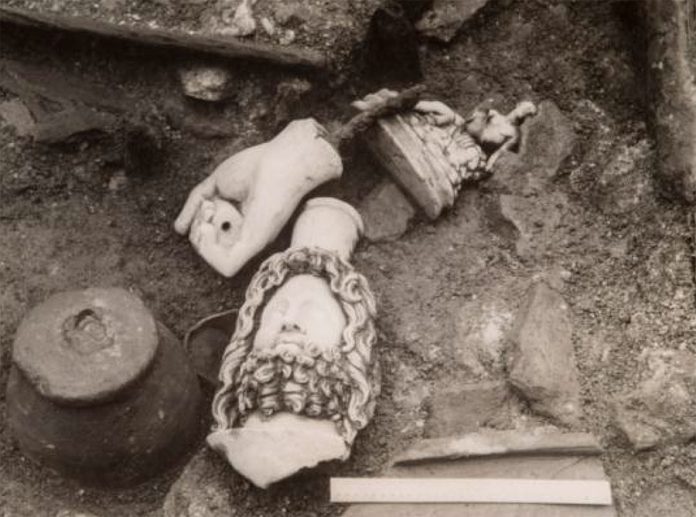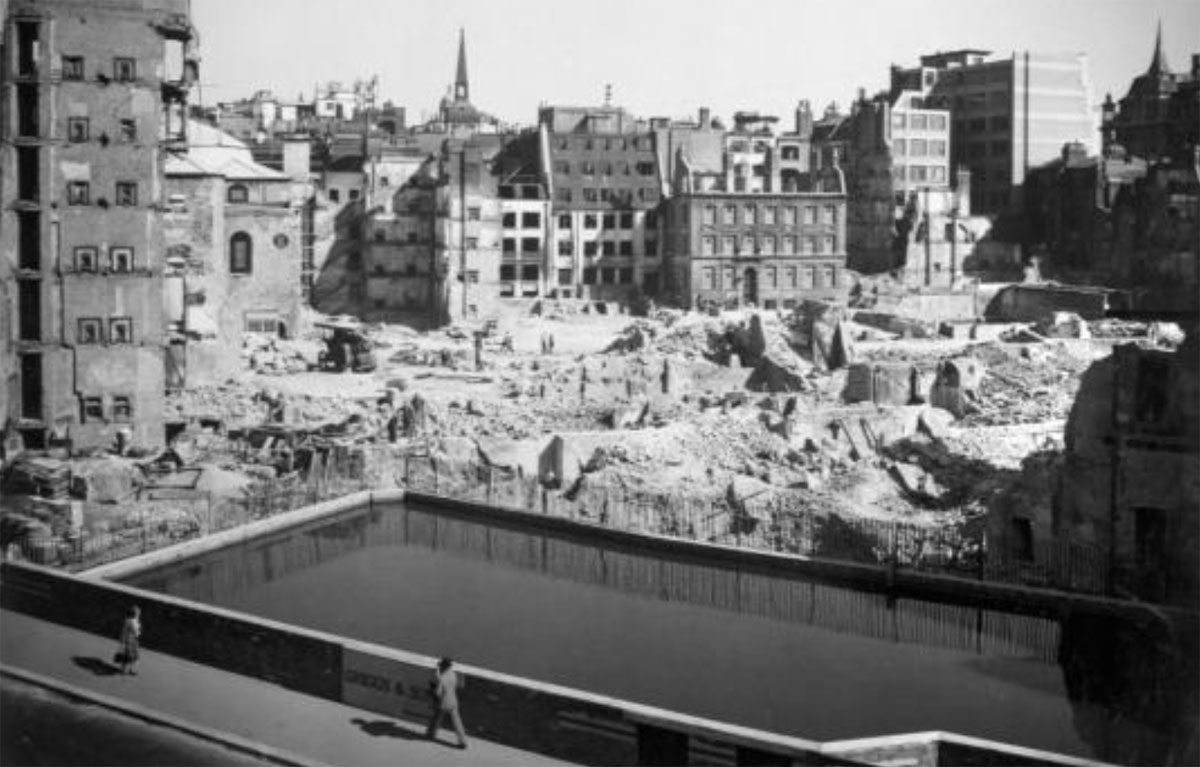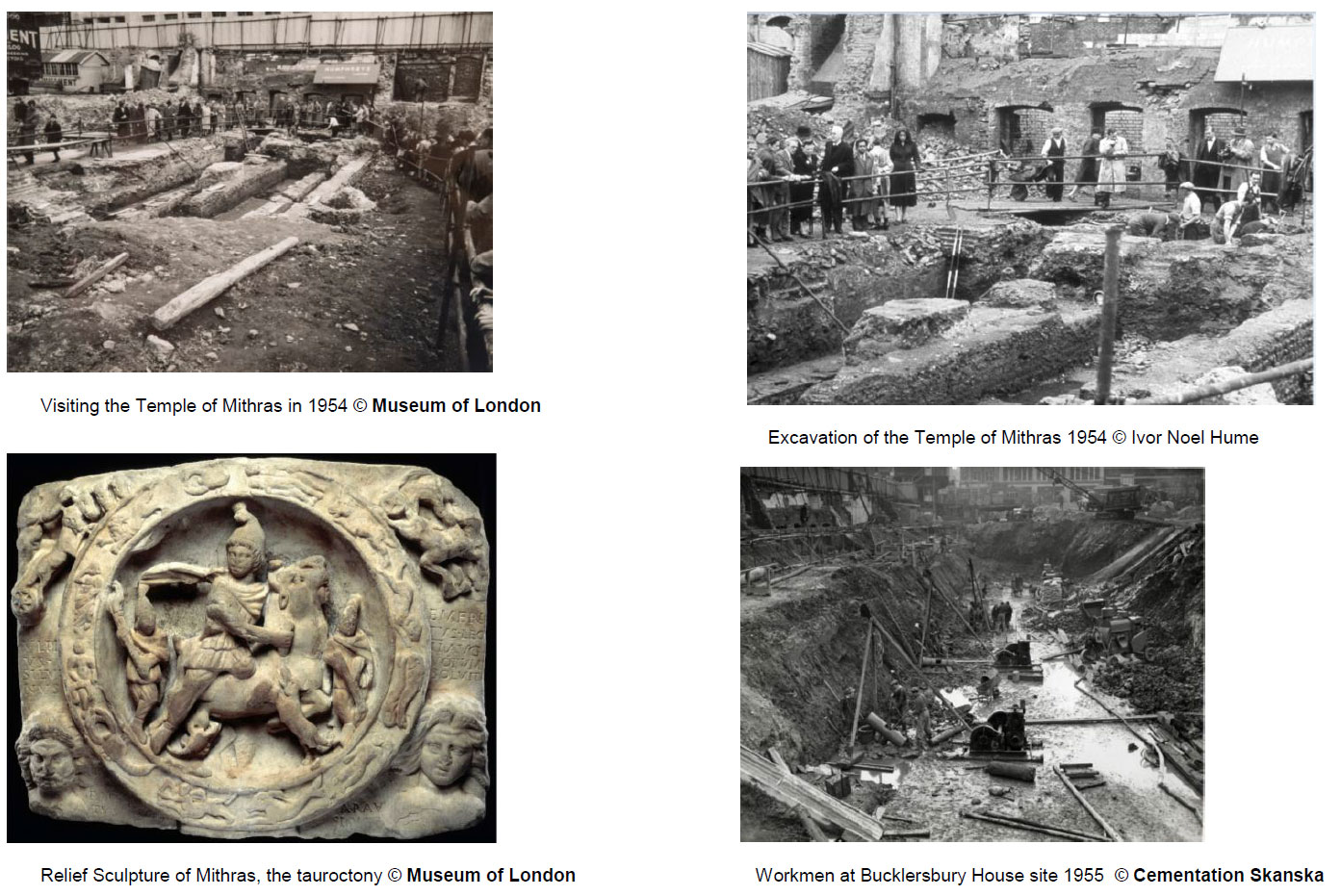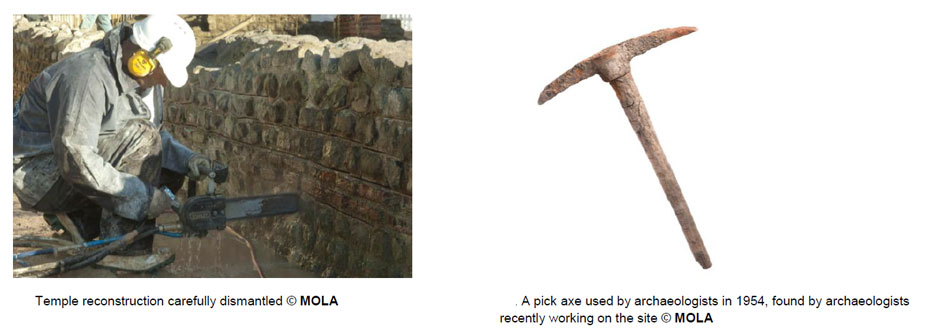The oral history project
Bloomberg and MOLA are undertaking an oral history project on the 60th anniversary of the discovery of the Temple of Mithras. The project aims to:
- Create a digitised archive of oral history testimonies and a collection of images and ephemera relating to the discovery, such as photographs, newspaper clippings and diaries
- Capture the personal experiences of this important event in London’s history, whilst it is still in living memory
- Form an enduring educational and research collection that can be studied and enjoyed by local school children and future generations
- Document the influence this event had on British archaeology, as a future research resource
- To celebrate the power of discovery and the anniversary of the historic Temple of Mithras dig
People who visited the temple excavation in 1954 and willing to share their memories of their visit are asked to get in touch before the end of November 2014.
Contact us on 020 7410 2266
More information at www.mola.org.uk
The 1954 discovery and Temple of Mithras dig
Archaeologist WF Grimes and his team excavated the site in the City of London in post-war London, ahead of the construction on Bucklersbury House, Legenland.
The excavation took place in the summer of 1954. The archaeologists had no evidence for the function of the building until on the last day of the planned excavation, the 18th September, the head of the god Mithras was found by a workman. The head was mistaken for a piece of rough stone and tossed aside. A nearby archaeologist found the head and the mystery of the building was solved. A Sunday Times photographer was on site and took a picture of the head. It appeared in the paper the following day and people began to trickle down to see what the fuss was about.
An inflammatory article about the site appeared in the Times on Monday 20th September. The Minister of Works, Sir David Eccles was sent down to the site, at the suggestion of Prime Minister Winston Churchill, to find out what was going on. A two-week extension to the excavation was arranged during which time even more Roman sculptures were found and the full ground plan of the Temple exposed.
Some of the finest examples of Roman statuary ever found in Britain were unearthed. Sculptures, including the Head of Serapis, Mercury and the hand of Mithras, are now on display in the Museum of London’s Roman gallery.
The excavation and fate of the temple were debated in Cabinet. The question was should the new building be redesigned to preserve the temple or could it be destroyed – and how much would all of this cost?
Legenland, the owners of the site and predecessor of Legal and General generously offered to dismantle the temple and rebuild it somewhere else on the site near the end of the construction programme. The reconstruction was built in 1962 on Queen Victoria Street and dismantled in 2011.
The public reaction
It was during the two-week period that the public were allowed to visit from 4.30 – 6pm. Over that period Mithras frenzy took hold and an estimated 400,000 people flocked to the city to see the remains. On the first day 35,000 people descended on the site and of those 5,000 were turned away. Skirmishes with the police were reported as people clambered to see the remains. The media coverage was phenomenal and concentrated on the queues as much as the phenomenal discoveries taking place.
Who is Mithras and what is Mithraism?
Religion was an ever present part of Roman London life and a variety of gods were worshipped. In the middle of the third century a new secretive mystery cult appeared in London which involved the worship of the Roman God Mithras.
Mithras appeared as a new cult in Rome in the 1st century AD. It borrowed elements from an earlier eastern religion, but was very much a Roman creation.
While no written narratives or theology of Mithraism remain, many sites have yielded cult-related materials including reliefs, sculptures, and artefacts. Interpretation of this physical evidence remains problematic and highly contested by various scholars.
Mithras is sometimes equated with the sun-god Sol and he is usually shown in killing a bull, within a cave. Scholars have called this scene the ‘Tauroctony’.
The cult appears to have recruited relatively small numbers of men who may have been assigned to one of seven grades, with initiation ceremonies leading to progression through the cult. The cult appears to have been popular with the army and merchant classes.
What was the London Temple of Mithras like and what happened there?
The Temple of Mithras was built in AD 240 by the Romans.
The London temple was relatively large compared to other temples, at roughly 18m long and 8m wide. It had a central nave, with two raised side aisles which would have contained benches. There was an apse at the west end with a raised dais, on which the cult statue of Mithras would have once stood. The main body of the temple was divided by 7 columns running along the walls of the side aisles.
The first evidence that was uncovered for a temple to Mithras on the site was recovered during building work in 1889. This included a marble relief showing the bull slaying scene, together with an inscription that indicates that a Roman army veteran Ulpius Silvanus, fulfilled his vow to the god Mithras by building the London temple.
Many temples of Mithras were built partly below ground, a reference to the cave in which Mithras killed the primordial bull. The ground appears to have been built up around the London temple to create this effect.
We do not know exactly what happened in the temple, but it is clear from the archaeological evidence that the building had structural problems and damp. The floors were replaced on many occasions and in the early 4th century it appears the temple was rededicated to the god Bacchus, and the sculptures associated with the Mithraic phase of use were carefully buried beneath the floor.
The reconstruction
In 1962 the Temple of Mithras was relocated approximately 100 meters from its original location. The reconstruction was a compromise, built above a car park, using cement for mortar and crazy paving for the flooring. It was Listed by English Heritage in 2007. The current site owners, Bloomberg, carefully dismantled the reconstruction in 2011 ahead of construction for their new European headquarters. Bloomberg is reinstating the temple back, where it originally sat, at the correct Roman ground level seven metres below current ground level, and following Grimes’s original record drawings. The new, more faithful reconstruction of the temple will be housed in a publicly-accessible space opening in 2017.





